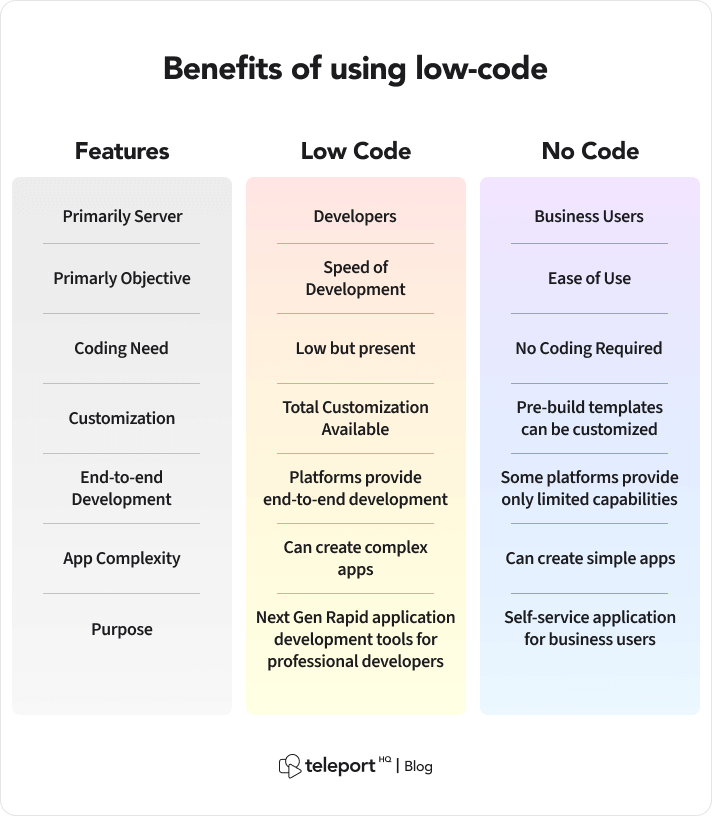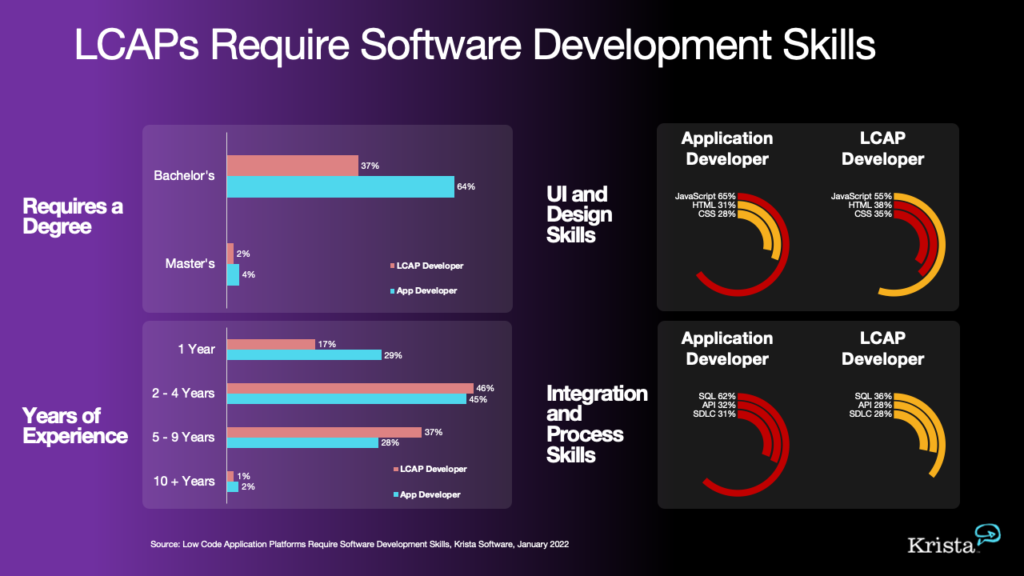Great Facts To Selecting Legacy application modernization with Low-code
Advantages Of Low-Code Application Development In Terms Of SpeedDevelopment of low-code applications significantly increases the speed of development due to a variety of important factors. Development Environment:
Drag-and-Drop Interfaces: Low-code platforms provide visual tools for designing applications. Drag-and-drop elements are a great tool for developers to create apps without extensive code.
Pre-built Templates and Components A lot of low-code platforms have templates and components that are pre-built, which allow developers to rapidly develop and test applications without having to start from scratch.
Reduced Coding requirements:
Automated Coding Generation Low-code platforms generate the code automatically based on the visual model designed by the developers. This means that there is less manual coding.
Reusable Parts Developers will be able reuse reusable parts across different projects, and cut down on the amount of time needed to write and testing code.
Streamlined collaboration:
Low-code development platforms are often equipped with tools like deployment, version control, and testing. This enables seamless collaboration across teams.
Citizen Development: Non-developers and business users can utilize simple interfaces to help in the creation of applications, which can reduce bottlenecks caused by a shortage of professional developers.
Rapid Iteration, Prototyping:
Rapid Prototyping Developers are able to quickly build prototypes for ideas to be evaluated and feedback collected and analyzed, which leads to faster iterations.
Simple Modifications. Low-code development's visual nature makes it easy for users to modify and upgrade their software.
Pre-built Integrations:
API Integrations. Low-code platform often come with pre-built connectors as well as APIs for the most popular services, which reduces the time needed to connect other systems.
Data integration tools: Tools to integrate data are included to help simplify the process.
Deployment & Scaling
One-Click deployment: A lot of platforms using low-code provide the option of deploying with one click applications, thus reducing the amount of time and effort.
Cloud-Based Solutions: Cloud-based low-code platforms can manage scaling and infrastructure management which allows developers to concentrate on application logic and functionality rather than deployment logistics.
The most significant benefit of low code application development in terms of speed, is the ability to automate and simplify a variety of aspects in the development process. This allows rapid delivery of software and faster adaptations to evolving requirements. Take a look at the recommended Low-code Platform for application development advice for website tips including driver jdbc, rapid action development, low code development platforms, rapid application design, cross platform mobile dev, develop web app, push notifications, application development platforms, software for app development, paas service and more.

The Advantages Of Low-Code Development In Terms Of Flexibility, Scalability And Scalability
Low-code app development provides several advantages, such as scalability and flexibility in design of the application. These are important for creating applications that can respond to changing requirements and expand with the needs of the business. Here are a few of the main benefits.
Cloud-based Deployment : Many low-code platforms are cloud built. This allows applications to scale seamlessly along with the cloud infrastructure. This allows businesses handle increased demand without worrying about managing servers.
Auto-Scaling Features - Built-in automatic scaling features automatically adjust resources according to the demands. This allows for continuous performance, even in peak times without the need for manual intervention.
Flexible Architecture:
Modular Design: Low-code platforms support modular application design, where components can be developed independently, tested, and scaled. Modularity increases flexibility, and it is simpler to upgrade specific components of an application without having to alter the entire system.
Microservices Integration: Support for microservices architecture allows applications to be built as a collection of loosely coupled service, increasing both flexibility and scalability.
Custom-designed solutions:
Extensibility. Low-code platform typically allows the creation of custom scripts or coding. This allows developers to enhance the capabilities of the software beyond what it comes with from the box. This allows the fulfilment of business needs that are unique without limits.
Third-Party Integrations: The capability of companies to integrate APIs and applications from third parties, as well as add new features to their application when needed, enhances its capabilities.
Agile Development and deployment
Continuous Delivery and Deployment Low-code platforms can be used to implement agile methods which allow continuous integration as well as continuous delivery (CI/CD). This lets applications be updated and upgraded quickly as a result of feedback from users.
Iterative Development: Because of the iterative nature low-code software can grow and grow slowly. This reduces the potential risk of major changes and allows for more controlled expansion.
Resource Optimization:
Efficiency in Resource Management: Low Code platforms can optimize resource usage through tools that monitor and control the performance of applications. It ensures that resources are used efficiently, and can be can be scaled up or down in accordance with the needs of the moment.
Load Balance: This function allows the application to handle heavy traffic by distributing workloads across multiple servers. This also ensures the application's performance is constant.
Global Reach:
Multi-Region Deployment: Low-code platforms generally support deployment across multiple geographical regions, which allows companies to offer low-latency connectivity to users around the world. This is especially important for applications that have a large global user base.
Localization: Support for localization is included, which allows for applications to be easily adjusted for various languages or regional needs. This increases flexibility for diverse markets.
Maintenance and updates
Maintenance is simplified because of the modularity and appearance of low-code applications makes maintenance easier and allows for rapid fixes and updates to be applied without lengthy downtime.
Version Control: Integrated version control systems handle rollbacks and changes in order to make sure that upgrades can safely be deployed and that previous versions are restored when needed.
Cost Efficiency:
Low-code platforms reduce development costs by reducing the need for extensive code. They allow developers to scale applications with no need for a significant cost or effort.
Pay-As-You-Go Models A lot of low code platforms offer flexible pricing like the pay-as-you-go model, which ties prices to usage as well as growth. This gives financial flexibility.
Overall, the scalability and flexibility benefits of low-code development enable businesses to build robust, flexible and scalable applications quickly. These platforms are able to quickly adjust to changing demands and efficiently use resources, and continually improve, allowing apps and companies alike to grow and grow. View the top get more info on Legacy application modernization with Low-code for website advice including app modernization, develop web app, rapid applications, azure sql, rapid app development, cross platform mobile dev, microsoft azure sql, build with docker, cross platform mobile app development, software for app development and more.

Regarding Support From Vendors And Community, Low-Code Applications Development Has Many Advantages.
Low-code development platforms have significant advantages when it comes to vendor support and the community. These are important to ensure successful implementations, continuous maintenance, and constant development. Here are a few of the benefits.
Comprehensive Technical Support:
Dedicated Support Teams A lot of low-code platforms have dedicated support teams that can help with technical issues, problem-solving, and guidance. This will ensure that any issues will be quickly resolved.
Certain vendors offer support 24 hours a day. This is advantageous for companies operating across time zones.
Training and Onboarding
Vendors typically offer organized programs for users, such as tutorials and webinars. They can also offer certificates.
Personalized Onboarding : Many vendors offer customized onboarding services that help new customers to integrate the platform and tailor it to suit their particular needs.
Updates and regular updates:
Continuous Improvement: Low-code platforms vendors often release regular upgrades that add new functionality as well as performance improvements and security patches. These updates make sure that their platform remains current and secure.
Feedback Integration: Many vendors incorporate user input into their development cycles. This helps ensure that the platform is able to adapt to the changing needs and wants of its customers.
Comprehensive Documentation:
Documentation is thorough users are able to access a large and well-organized documents that range in complexity from basic customization to advanced.
API References In-depth API documentation allows developers to create custom applications and integrate low-code platforms into other systems.
Professional Services and Consulting
Expert Consultation. Vendors offer a wide range of consulting services including the design of architecture, strategic planning and complex platform implementations. These services ensure users are able to maximize the benefits of their platform.
Custom Development: Certain vendors provide services that permit the development of specific features or integrations, which aren't available from the beginning.
Community Support for the Community
Active User Communities:
Forums and discussion boards: Many platforms with low-code have vibrant online community that allows users to get help, discuss solutions, and work together to discover the best practices.
User Groups and Meetups Local and virtual user groups and meetups provide opportunities to network, learn and sharing your experiences with other users.
Collaboration and Knowledge Sharing
Community-Contributed Resources: Users often share templates, modules, and extensions that they have developed, which can be reused or adapted by others, accelerating development and innovation.
Crowdsourced Solutions: The collective knowledge the experience, expertise and experiences of a community can be an effective tool for problem-solving and finding innovative solutions.
Learning and Development
Community-led training: Many communities offer webinars, workshops and training sessions led by experts in the field.
Online Courses and Tutorials Community members often create and share online courses, tutorials and how-to guides, improving the learning resources that are available to all users.
Feedback and Influence
Product Feedback Channels. Forums for community members usually have channels where you can provide feedback to the vendor. This feedback may influence the development and improvement of new features.
Beta Testing Programs: Members of the community who are active may have the opportunity to take part in beta testing programs, giving them early access to new features and an opportunity to participate in determining the future of the platform.
Recognition and Encouragement
Community Recognition Programs: Several vendors offer recognition programs to acknowledge the contributions of community members who are active like MVP (Most Valuable Professional) programs.
Peer Support Community members frequently offer support to peers through sharing their knowledge and offering guidance to users who are less knowledgeable. This creates a supportive friendly and supportive environment.
In general, the combination of robust vendor support, and an active and engaged community offers a wide range of support for development with low-code. This ensures that users have access to the resources knowledge, expertise, and collaborative opportunities to develop, deploy and maintain their applications improving the efficiency and effectiveness of their applications.
